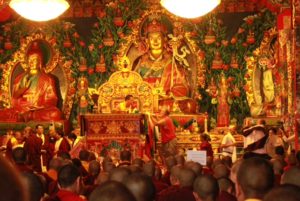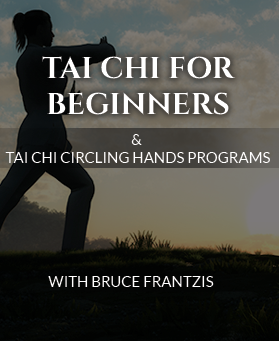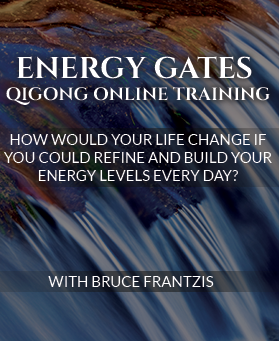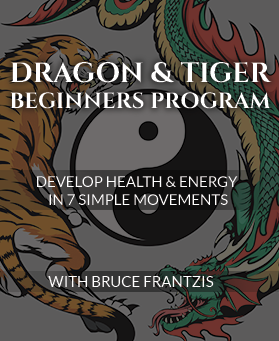Hi Folks,
Happy Lunar New Year!
I’d like to share with you an update on what’s happening with Energy Arts in the coming year. This includes new events and products. It also includes a few personal breakthroughs with the training and meditation center, yang style tai chi and the energy of joy.
We have lots going on in the community this year and lots of ways you can learn and grow.
I want to personally acknowledge all of the instructors who are actively teaching, whether it be one person or more. Every time you share and help others it matters. Every small thought and action is noticed by the Tao or universe. Sometimes it takes a while to start teaching others…but I encourage everyone to share according to his or her abilities now and in the future. By teaching you improve yourself, find your gaps, and it also is a great motivator to keep practicing.
The Energy of 2015
As many of you already know, at the start of the year is an ideal time to point yourself in a good direction.
It’s also a great time to let go of any guilt or regret so you can move forward. Sometimes people focus on what is coming without making space for the new. So take an inventory of any leftover residual energy, negative emotion and stories and let them go. Of course, it makes sense to look at your last year so as not to repeat the same patterns.
This year in numerology is an 8 year (2+0+1+5=8). This indicates abundance and prosperity. As a late friend used to make a joke, “If it’s raining chicken soup hold out a cup!” Let’s put it this way. If you would like to have more of anything, this is the year you want to set and track your goals month by month. This is true for money and other forms of wealth such as qi.
At the start of most years I get asked, “Bruce, what would you recommend I do or practice?” Every year my answer is the same, “Pick a primary practice and do it two hours a day if you really want to get good.” Now I know practicing two hours a day is a commitment, even 30 minutes may be a push, but these practices work if you spend the time to get them in your body.
With qi, if you approach your practice with a long-term approach, and avoid not getting suckered into the instant gratification trap, you’ll build qi and awareness overtime to get stronger and healthier day-by-day. So commit to a set amount of time and place to practice each day and find a person or group to practice with to keep you accountable. I encourage people to think in 12 week or three month cycles. Set a goal for 90 days and then the next and then the next.
Taoism and High Performance
Practicing at a regular time and building accountability are all part of high performance. I have recently started a short book on this topic because I think it is very relevant to Westerners. The book will be about how the concepts from Taoism can help people break through the performance glass ceiling.
The Taoist had specific approaches on how to do this for the healing, health and martial arts based on many years of research and training advanced practitioners.
The art of becoming a real adept in any type of energy work and meditation really only comes from adopting a high performance perspective. You can achieve lower levels doing less than your best, but not the higher levels. I think this book will be useful and interesting to many in our community. Books always take much longer than expected but most likely a digital version will be available this year.
Taoist Training and Meditation Center
Last summer I shared with you the vision for the Taoist Training and Meditation Center, and this year we are going to manifest the first steps.
As many of you know, I have taught as much as possible outside a permanently sealed space. The Center will allow us to train the highest-level teachers and hold extended courses on subjects such as qigong tui na healing, advanced levels of qigong and tai chi, and Taoist meditation that are greatly needed at this time. It is envisioned there will be a main center in Europe and a smaller center in Maui.
For further growth of the entire community and for further application of Taoist teachings in the world, we need to move forward. What is clear is that the Center will take concerted effort from the entire community. We are aiming to get the first seed funding by June and we will start to look at potential sites in Europe. A small group of us met just before Christmas and we will share a detailed plan for moving forward.
Yang Style Tai Chi Form
For the last 20 years many have asked that I teach some form of Yang Style tai chi. In the past I wanted to teach the material in the Wu Style tai chi first, mainly because of my primary teacher and because of its connection to meditation. I will continue to teach the Wu Style but it has become very clear that now is the time for me to teach more of the Yang Style as well.
This Yang form will have 36 movements and will be based on the Old Yang Style. The outline for this program is already over 200 pages and I will be sharing with you the inner tai chi tradition for this form.
This will be an exciting program and I think one that will be seminal for any tai chi practitioner. We will start filming this early in the year and will let you know more about this in the May-June time frame.
Tao Te Ching – A Practitioners Guide
Three years ago I started a project with Dr. Alan Peatfield to create a new version and guide to the Tao te ching. Why? Almost all of the translations of this important book from Taoism have been written by academics who were not Taoist practitioners. Most of the books are inspirational and mental.
Very few in the West actually know the context of the book and where it is coming from. Like many great books, the book has layers and layers of deeper meanings. Inspiration is just the first level.
My teacher, Liu Hung Chieh, took me through the book from the perspective of what each of the phrases meant from the perspective of a Taoist practitioner. This is someone who one actually practices qigong, tai chi and Taoist meditation and in the perspective of the Chinese tradition.
The Tao te ching was also a continuous course of practice for seven years as I was becoming a Taoist priest. At the time I went through hundreds and hundreds of practices related to this important book.
I wanted to mention the program here because each month we release a new chapter. Currently we have released the first 31 chapters. If you have an interest in the Tao te ching this is probably one of the best resources and there is nothing else like it in the West or East.
Gods Playing in the Clouds Instructor Training
This summer for the first time in Europe we will be holding a Gods Playing in the Clouds Instructor Training. Those of you in the Energy Arts Training Circle will go through all the moves before the retreat.
This is the highest level qigong set in my system and one that incorporates all of the 16-part neigong, much as tai chi does. If you are serious about teaching then I encourage you to apply for this training. It can be life changing.
Trip to Tibet
Last year I took an extended trip to India and Nepal. As part of that trip I continued studying Dzogchen and was authorized to teach the subject if I wanted to by Lama Wangdor. During the retreat I spent most of my time doing the second half of Dzogchen practices.
My primary teaching responsibilities are within Taoism, but I mention Dzogchen here because there are many in the community that also practice Tibetan Buddhism. As I move deeper into meditation I think this is going to be useful to many in our community who practice Buddhism to understand both perspectives.
It is likely that I will be in Tibet at the end of the year to continue these practices.
The Three Deities

This is the real reason that it is useful to meditate with masters. It is not necessarily what they say, although this is important too. Even more important is what they transmit which is beyond ordinary thinking. It is a transmitted state of being.
Different meditation masters transmit different state of being. The highest masters can transmit a wide range of states. In the East different Deities represent archetypical energies and states that we learn to embody on our spiritual path. One way to look at these Deities is in three different categories.
The first kind of deities are wrathful and they represent the smashing of the ego. This is the fastest way to wake up people. But it can also be a bit dangerous and not everyone can take this path. People love their egos and when you go against them often this approach is not effective to crack through to what is real.
It could be said that recognizing the proper role of the ego is one of the primary purposes of many spiritual practices.
The second kind of deities are peaceful and represent the virtues of compassion and higher positive emotional states as well as balance. This is a slower path but one that is easier for most. The challenge with this path is it can make you complacent. You will want to avoid anything negative and never really face the dark parts within. When stuck here it is possible to live in a fairy tale or protected life without much growth.
The third and last kind of deities represent joy. For example, in the East this is often depicted in Tantra. Most think Tantra is about the sex or energy, but it actually has to do with the higher form of joy that can be released. Most people experience joy as an all or nothing phenomenon. It is a rush and then a crash. There is a higher level of relaxed joy that does not have these huge swings and crashes. This is the place where inspiration can flow without any effort. My teacher Liu Hung Chieh had a calm and even joy. For him it was a constant state, a multi-dimensional experience.
What became very obvious last year is that I want to help others understand this more stable part of joy. Many in the West actually have a great fear of joy. The state feels unnatural and uncomfortable because it is a higher level of energy.
I am looking forward to infusing this gentle joy into my teaching for the coming year.
Go Beyond Inspiration
I guess one of the things in the West is to read or study or take a retreat to get inspired and motivated. For those of you who know me I am not very good at the rah-rah stuff.
I believe when you truly find a path you love you go beyond inspiration. For some that is healing. For others martial arts or meditation. You know you have connected to your true there was something there that they had achieved but it was up to me to do the same work they did to get there. I never once had an inspirational talk from my teacher Liu.
He would say, ‘If you want to go here then this is how you get there. If you want to arrive at this place here is a battle plan.’ It was a success plan. It was not a wish plan. This was inspirational to me.
This is one of the reasons I don’t read fiction. If it is worthwhile then I want find out what is out there and what could be done directly. If you lead a real life, fiction is not as interesting because you’re out there doing it. People who do things are not as blown away by fiction because they are living it.
I have gone through many things in my life that would break most people (broken body and illness, betrayals, theft, etc.). In each case I had to look within. So is life. Every day is a new chance. It is just a question if you want it.
What enables you to stay on task is your Karma.
I think it is worthwhile also to examine your drive. Some have drive and some don’t. You can increase your drive. By looking at your drive you change it. But you have to have to be interested in the concept and recognize when and where it arises in your life and practice. Keep putting one foot forward and don’t fall prey to self-pity. Every time you hear yourself go woe is me then put it in perspective because there are always those in far worse conditions. Just get on with the show.
If you want to be successful in Taoist practices think long-term. There is a phrase in the tai chi classics that sums this up, ‘Don’t forget the near for the far.’ Stay on track in the moment. What do you have to do now? This phrase is also true from the other side. ‘Don’t forget the far for the near.’ Keep your larger goal in mind so you know where you are going.
What we are offering in Energy Arts is the opportunity to practice something that is real. That’s it. To someone who has a genuine interest in energy and spiritual development, this is the point. I think that is the reason why many people respond to the teachings and transformation happens.
If one practices, good things happen. Whatever it takes to take action and develop a regular practice, do it.
This year be your own hero.
This year be your own inspiration because the road of the Tao never stops.
Keep practicing,
Bruce Frantzis





Taoism and Dzogchen
As a long-time student of both Buddhism and tai chi and a dzogchen practitioner, I find your link interesting. While reading your book, “Opening the Energy Gates of the Body” parts of it bring the dzogchen practice to mind, particularly ‘dissolving the chi’ is almost a tangible form of dzogchen! Indeed I now mingle the practices during my meditation sessions. Thank you for sharing your knowledge with the West.
Numerology
I’m confused as to why Bruce mentions numerology here.
I just can’t get past how arbitrary it seems to me. The year is based on a the Christian calendar, which doesn’t seem to have any universal basis other than an historical event. Also, the use of base ten arithmetic and the choice to add individual digits rather than, say, multiply them, seems very random.
Do Taoists generally take numerology seriously? If so, could someone explain on what basis?
Thanks for the Update
A lot of wisdom in what you shared here. Many thanks. Especially looking forward to the Yang form instruction.
State of the Tao 2015
Hello Everyone,
As one who can be easily distracted by my “woe’s me”, I laughed when I read to just “get on with the show”.
That’s quite an agenda for the upcoming year. It’s inspirational.
Thanks!
Theresa
my heart
I had a bad heart attack last year and was doing good but recently I went off my eating and exercise pattern and am getting to fatigued especially after I eat. I would like to learn the qigong exercise to rejuvenate my heart, if possible. I am 66 years old and was always in fair shape and felt much younger than I was. I got so much stress do to illnesses in the family that I believed caused my heart attack. I want to recover and feel strong again. I took karate and tai chi many years ago. When all the stress started I was taking a form of Qigong called Yi Chuan in Boston’s Chinatown, which probably helped save my life. I will re-start Yi Chuan as soon as I get a little stronger. Any suggestions or some of your courses that can help my heart get better, please advise me .
Thank you,
John Villa